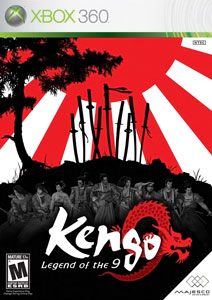Kengo
| Kengo | |
|---|---|

Kengo: Legend of the 9 cover art
|
|
| Genres | Fighting |
| Developers |
Light Weight Genki |
| Publishers |
Crave Entertainment Majesco Entertainment |
| Platforms | PlayStation 2, Xbox 360 |
| Aggregate score | |
|---|---|
| Aggregator | Score |
| Metacritic | 62/100 |
| Review scores | |
| Publication | Score |
| Edge | 6/10 |
| EGM | 5.83/10 |
| Famitsu | 31/40 |
| Game Informer | 7.25/10 |
| GamePro | |
| Game Revolution | C− |
| GameSpot | 5.9/10 |
| GameSpy | 52% |
| IGN | 6/10 |
| OPM (US) | |
| Aggregate score | |
|---|---|
| Aggregator | Score |
| Metacritic | 38/100 |
| Review scores | |
| Publication | Score |
| Game Informer | 2/10 |
| GameSpot | 3/10 |
| GameSpy | |
| GamesRadar | |
| GameTrailers | 4.8/10 |
| GameZone | 3.5/10 |
| IGN | 3.5/10 |
| OXM (US) | 3.5/10 |
Kengo (剣豪) is the name of a series of video games developed by Genki. Kengo is considered a spiritual successor to the Bushido Blade game series for the PlayStation.
Released for the PlayStation 2 as Kengo in Japan by Genki on December 14, 2000 and as Kengo: Master of Bushido in North America and Europe on January 3, 2001 and March 30, 2001 respectively by Crave Entertainment. It was universally panned as a "disappointment", mostly blasted in sharp comparison to the Bushido Blade titles.
While Kengo's graphics are sub-par for PlayStation 2, Kengo possesses some unique gameplay features. Although they evolved from Light Weight's previous Bushido Blade titles, their depth are the strongest factor of this title. There is only one button for attack and success is achieved through patience, timing, and skill.
The single player game is divided into three sections. The first two are training and challenging other schools. Training is divided into multiple mini-games that focus on one aspect of gaming, timing or button combos for example. The training serves to increase the maximum value of various character statistics, but not augment their actual value. The simple nature of the training quickly becomes repetitive. Challenging the other schools consists of fighting four identical-looking students, one unique student, and the school's master. The battles use wooden swords but are consecutive and of increasing difficulty, you regain a small amount of health between matches.
After defeating each rival school, you earn your own place as the head of a school. Randomly, you will have access to the Imperial Tournament, which is the final goal of the game. The tournament is fought with steel swords and you start each match with full health. You can still challenge other schools and victory earns you their school's sword. Equipping different swords gives you a unique "special move". At this point in the game you will be randomly challenged by either the master or unique student of other schools and cannot decline. Losing such random encounters strips your character of that school's sword.
There is no gameplay to speak of outside of battle or training. The interface is strictly menu based. Subtle features such as being able to "break" swords in training and having to wait for them to be repaired add to the game's realism. Both the life bar and the Ki bar (which allows special moves) can be hidden from battle to create a more intuitive player. The status of a wounded character is still displayed during battle.
...
Wikipedia
